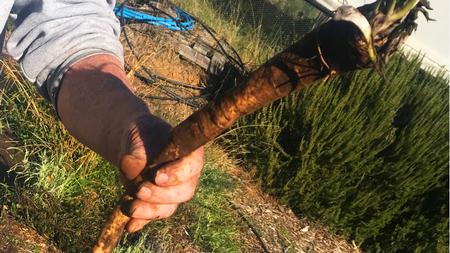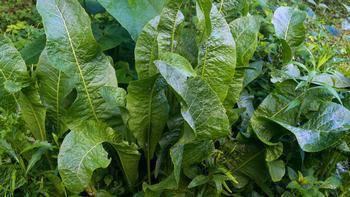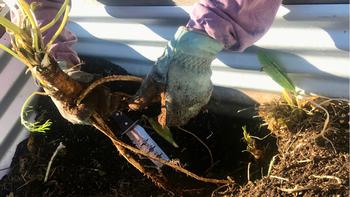News from the Edible Demo Garden
December 2022: Horseradish Harvest

What kind of plant is horseradish?
Horseradish, Armoracia rusticana, is an herbaceous plant in the Brassicaceae or mustard family. It can be considered a root vegetable, although it is primarily used as a spice or condiment. It is native to southeastern Europe and has been cultivated for around 3,000 years for both its taste and its medicinal properties. It is rich in vitamin C, calcium, and other nutrients and has been shown to have anti-inflammatory, anti-bacterial, and even anti-cancer health benefits.
Horseradish is related to Wasabi japonica, the source of the wasabi paste usually eaten with sushi. Due to limitations in the cultivation and availability of the Japanese wasabi plant, western horseradish, with green coloring added, is often used as a substitute for true wasabi.

Horse radish plants are grown from root cuttings planted in late winter or early spring. Although classified as a perennial, horseradish plants are best treated as an annual because after two or three years the roots become too large and tough. The plants prefer a sunny location with well-amended soil and regular watering. Any fertilizer used should be high in potassium and phosphorus and low in nitrogen. Too much nitrogen encourages leafy growth and underdeveloped roots.
In the spring the horseradish plant produces large, weedy-looking green leaves. Underground, the white, fleshy roots develop. By late fall the roots should be around the size of a large carrot and ready to be harvested. The roots are fragile and need to be dug up carefully. Even in the fine textured soil in the Edible Garden raised beds, it took considerable care and effort to successfully extract the intact roots. While harvesting, some root cuttings were preserved and replanted for next year’s crop.
Horseradish is relatively easy to grow, and one plant can provide enough for the average family. However, it works best in a dedicated garden area because any root fragments left in the ground after harvest will produce a new plant.

The bite and sinus-clearing aroma of horseradish is produced by the volatile compounds that are released when the root cells are crushed. The roots are prepared by cleaning them, peeling them, and grating them finely. The grating is best done in a food processor with a little water added to aid in the grinding process. Ground up fresh horseradish is very potent, much more than chopped onions, so good ventilation and eye protection is strongly advised.
Once the root is finely ground, it’s time to add a tablespoon or two of vinegar to the mixture. Vinegar stops the reaction of the volatile compounds and controls the hotness of the ground horseradish. The grated horseradish can then be transferred to jars. It will keep in the refrigerator for at least a month and can be used in a variety of recipes. Most who have tried it agree that the taste of fresh horseradish is far superior to the supermarket options.
